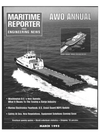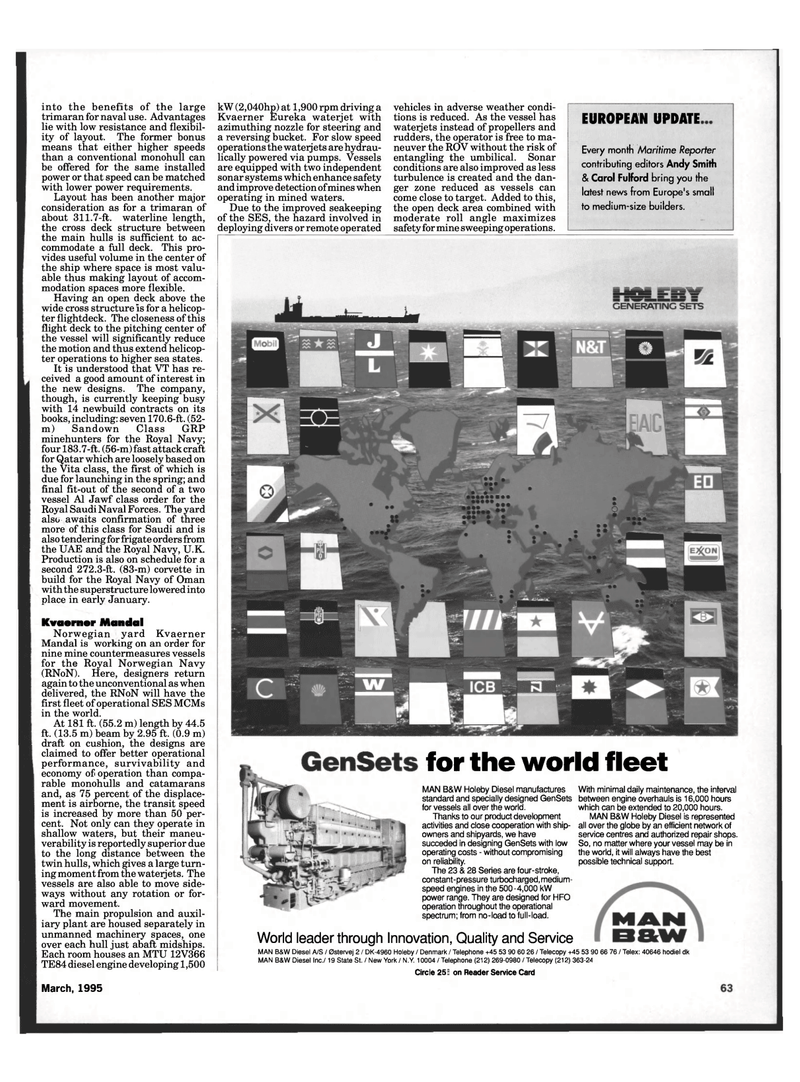
Page 61: of Maritime Reporter Magazine (March 1995)
Read this page in Pdf, Flash or Html5 edition of March 1995 Maritime Reporter Magazine
into the benefits of the large trimaran for naval use. Advantages lie with low resistance and flexibil- ity of layout. The former bonus means that either higher speeds than a conventional monohull can be offered for the same installed power or that speed can be matched with lower power requirements.
Layout has been another major consideration as for a trimaran of about 311.7-ft. waterline length, the cross deck structure between the main hulls is sufficient to ac- commodate a full deck. This pro- vides useful volume in the center of the ship where space is most valu- able thus making layout of accom- modation spaces more flexible.
Having an open deck above the wide cross structure is for a helicop- ter flightdeck. The closeness of this flight deck to the pitching center of the vessel will significantly reduce the motion and thus extend helicop- ter operations to higher sea states.
It is understood that VT has re- ceived a good amount of interest in the new designs. The company, though, is currently keeping busy with 14 newbuild contracts on its books, including: seven 170.6-ft. (52- m) Sandown Class GRP minehunters for the Royal Navy; four 183.7-ft. (56-m) fast attack craft for Qatar which are loosely based on the Vita class, the first of which is due for launching in the spring; and final fit-out of the second of a two vessel A1 Jawf class order for the
Royal Saudi Naval Forces. The yard also awaits confirmation of three more of this class for Saudi and is also tendering for frigate orders from the UAE and the Royal Navy, U.K.
Production is also on schedule for a second 272.3-ft. (83-m) corvette in build for the Royal Navy of Oman with the superstructure lowered into place in early January.
Kvaerner Mandal
Norwegian yard Kvaerner
Mandal is working on an order for nine mine countermeasures vessels for the Royal Norwegian Navy (RNoN). Here, designers return again to the unconventional as when delivered, the RNoN will have the first fleet of operational SES MCMs in the world.
At 181 ft. (55.2 m) length by 44.5 ft. (13.5 m) beam by 2.95 ft. (0.9 m) draft on cushion, the designs are claimed to offer better operational performance, survivability and economy of operation than compa- rable monohulls and catamarans and, as 75 percent of the displace- ment is airborne, the transit speed is increased by more than 50 per- cent. Not only can they operate in shallow waters, but their maneu- verability is reportedly superior due to the long distance between the twin hulls, which gives a large turn- ing moment from the wateijets. The vessels are also able to move side- ways without any rotation or for- ward movement.
The main propulsion and auxil- iary plant are housed separately in unmanned machinery spaces, one over each hull just abaft midships.
Each room houses an MTU 12V366
TE84 diesel engine developing 1,500 kW (2,040hp) at 1,900 rpm driving a
Kvaerner Eureka waterjet with azimuthing nozzle for steering and a reversing bucket. For slow speed operations the wateijets are hydrau- lically powered via pumps. Vessels are equipped with two independent sonar systems which enhance safety and improve detection of mines when operating in mined waters.
Due to the improved seakeeping of the SES, the hazard involved in deploying divers or remote operated vehicles in adverse weather condi- tions is reduced. As the vessel has waterjets instead of propellers and rudders, the operator is free to ma- neuver the ROV without the risk of entangling the umbilical. Sonar conditions are also improved as less turbulence is created and the dan- ger zone reduced as vessels can come close to target. Added to this, the open deck area combined with moderate roll angle maximizes safety for mine sweeping operations.
EUROPEAN UPDATE
Every month Maritime Reporter contributing editors Andy Smith & Carol Fulford bring you the latest news from Europe's small to medium-size builders.
With minimal daily maintenance, the interval between engine overhauls is 16,000 hours which can be extended to 20,000 hours.
MAN B&W Holeby Diesel is represented all over the globe by an efficient network of service centres and authorized repair shops.
So, no matter where your vessel may be in the world, it will always have the best possible technical support. for the world fleet
MAN B&W Holeby Diesel manufactures standard and specially designed GenSets for vessels all over the world.
Thanks to our product development activities and close cooperation with ship- owners and shipyards, we have succeded in designing GenSets with low operating costs - without compromising on reliability.
The 23 & 28 Series are four-stroke, constant-pressure turbocharged, medium- speed engines in the 500-4,000 kW power range. They are designed for HFO operation throughout the operational spectrum; from no-load to full-load.
World leader through Innovation, Quality and Service
MAN B&W Diesel A/S / Ostervej 2 / DK-4960 Holeby / Denmark / Telephone +45 53 90 60 26 / Telecopy +45 53 90 66 76 / Telex: 40646 hodiel dk
MAN B&W Diesel Inc./19 State St. / New York / N.Y. 10004 / Telephone (212) 269-0980 / Telecopy (212) 363-24
Circle 215 on Reader Service Card
March, 1995 85

 60
60

 62
62
